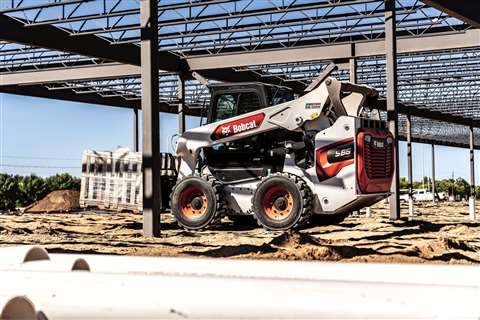Skid-steer market is aging well
08 November 2022
 Even though skid steers have fallen short of the sales levels they saw in the early to mid-2000s, there’s still a sizable quantity of machines sold every year. (Photo: Bobcat)
Even though skid steers have fallen short of the sales levels they saw in the early to mid-2000s, there’s still a sizable quantity of machines sold every year. (Photo: Bobcat)
With the warmer months behind us now, it’s time to start preparing for wetter and colder climes ahead. As this weather transition begins to take hold each year, it brings to mind the tumultuous relationship between the skid-steer loader and the compact track loader.
While the two machines are very similar in most ways, skid steers are wheel-based whereas compact track loaders (CTLs) are equipped with crawler tracks. Although relatively similar in stature, the two machines have diverged widely in their sales trajectories over the years, with CTL sales increasing rapidly and skid-steer loaders (SSLs) losing more and more ground to their tracked counterparts.
This divergence has been slow in the making. CTLs saw their percentage of sales continue to rise, increasing from 74% of the combined sales of SSLs and CTLs in 2020 to 76% last year. The growing gulf between the machines’ sales trends becomes more apparent when viewed from a longer-term perspective. CTLs accounted for a little over half (58%) of the combined sales in 2016 but are now over three-quarters. From an even longer-term view, the sales relationship essentially flip-flops. In the mid-2000s, at the peak years of SSL sales, they accounted for 74% of the market, far outpacing the CTLs’ 26%.
SSL advantages
The stunning growth of CTLs – both in relation to skid steers and in absolute numbers – has led to speculation that the skid steer will continue to see its popularity diminish. At the same time, the SSL does have advantages.
Because of their lower ground pressure and ability to work in more challenging work environments such as wet or muddy conditions, CTLs are the preferred machine for jobs on unpaved surfaces. As they are propelled by tires rather than tracks, SSLs are the machine of choice for paved surfaces. Another appealing attribute is that SSLs are generally less expensive to purchase and own and are faster on jobsites, moving more material in less time, which can reduce expenses.
Their superiority in working on hard surfaces also makes the skid steer the preferred machine for applications such as planing on concrete and asphalt and lift-and-carry duties. These key advantages guarantee that skid steers will always have a piece of the market, even if they have lost ground to CTLs.
And the reality is, even though skid steers have fallen short of the sales levels they saw in the early to mid-2000s, there’s still a hefty quantity of machines sold every year – more than 28,000 units last year alone.
OEMs innovating
 Peter T. Yengst is president of Yengst Associates, a market research and consultancy in Wilton, Conn. www.yengtassociates.com [email protected]
Peter T. Yengst is president of Yengst Associates, a market research and consultancy in Wilton, Conn. www.yengtassociates.com [email protected]
Today’s OEMs also envision future sustainability for the skid-steer segment as they continue to innovate with new models, new technologies and new attachments. As an example, Bobcat introduced a new model in 2021, the S70, its smallest machine that measures just 6 ft. tall and 3 ft. wide. Its compact size allows the machine to work in extremely tight quarters and fit through doorways and gates. It can also work in low-ceiling structures.
What’s interesting is that the S70 is smaller than Bobcat’s smallest CTL, the T450, which is 6.5 in. tall and 4.58 ft. wide. Companies often produce identical versions of their CTLs and SSLs (except for the tracks and tires), so that their smallest wheeled and tracked machines have nearly identical builds/specifications. But not Bobcat.
Another innovation in skid steers has been electrification. The first fully electric machines were mini-excavators and compact wheel loaders, notably developed by Volvo and now coming to market. The first electric SSLs were developed by another European company, the Slovenia-based Kovaco, which now offers two electric skid-steer models. In 2020, Manitou, a well-established, longstanding participant in the North American market, demonstrated its 165E electric skid-steer concept at ConExpo. The company said the machine is suitable for performing applications typically associated with standard machines, but can also be used in indoor demolition work and in locations with noise restrictions, such as schools and hospitals.
So, despite the rise of the track loader, the SSL remains a significant part of the compact construction machinery world. And we expect skid-steer annual sales to stabilize at the 20,000- to 30,000-unit range in the years ahead.
Looking at the skid-steer loader market, Bobcat, one of the pioneers in the development of the machine in the late 1950s and early ‘60s, still reigns as the top dog in the pack with a commanding share of the market – nearly 40% – over its nearest competitor. It is followed by a group that includes big hitters like Kubota, Caterpillar, John Deere, CNH and Manitou.
The top six suppliers accounted for just over 80% of total industry sales last year. In recent years, some well-known OEMs, specifically Volvo and Takeuchi, have exited the business. Takeuchi now solely focuses its attention on its compact track loaders.
STAY CONNECTED



Receive the information you need when you need it through our world-leading magazines, newsletters and daily briefings.
CONNECT WITH THE TEAM







